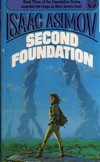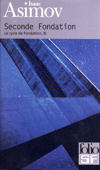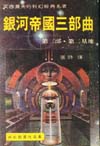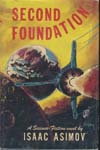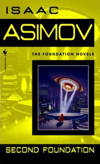Second Foundation
follows the Seldon Plan after the First Empire’s defeat and describes its greatest threat—the growth of a dangerous mutant. This mutant strain has gone wild, producing a mind capable of bending men’s wills, directing their thoughts, reshaping their desires, and destroying the universe. Second Foundation completes the most famous series of novels in all of science fiction by one many critics consider our greatest science-fiction writer, Isaac Asimov.
My very favorite of the Foundation books.
The book divides, like Foundation and Empire, into two very uneven sections, the first (“The Search by the Mule”) occupying about one-third the book and the second (“Search by the Foundation”) the remainder. Here, however, the sections are also very uneven in quality, not just in length.
“The Search by the Mule” is the weakest of the Foundation stories, bar none. Asimov was very, very tired of the Foundation series by this point and wanted to end it, he didn’t care how. His original plan, which John Campbell talked him out of, was to have the Mule find and destroy the Second Foundation. Seldon’s plan would then be completely wrecked, and Asimov would be free of the Foundation stories. (His hope, however, was that by reversing the ending—the Second Foundation triumphs, the Plan is restored, and nothing interesting ever happens again—he would still be free of the series.)
Asimov’s distaste for his subject shows here. The narrative involves a convoluted back-and-forth between the Mule’s expedition to find the Second Foundation and the Second Foundationers themselves. The Second Foundationers remain shadowy voices who are never allowed to show themselves (with the exception of their spy in the Mule’s camp) until the end, which confuses the narrative further. On the whole, this is a tired story by someone who didn’t really want to write it.
It is followed, however, by one of Asimov’s most brilliant pieces, ever. Again, Asimov hoped that he would show Seldon’s Plan firmly back on track and that this would let him end the series, and he nearly got away with it.
Everything is nearly perfect about this story, and we have to begin with the heroine. Arkady Darrell is a rarity in Asimov, a compelling and memorable character (and a female to boot). Characterization was never Asimov’s strongest point as a writer, but here he has succeeded brilliantly and created one of the most memorable characters in the history of science fiction. Most of the other characters in the story are nearly as good, although Preem Palver and his wife are rather stereotypical—and yet, even so, the stereotypes are well-exploited and vivid.
(One must admit that 1940’s morals show through. When the warlord of Kalgan decides to take Arkady as his consort, she—the romantic who sees conspiracies everywhere—has no idea of his sexual intentions and everybody else is shocked beyond belief. Of course, some of that shock is pretense, but, still—sixty years later, when sexually exploited fourteen-year-olds are seen with some regularity on Law and Order: Special Victims Unit, the horror of the scene is somewhat muted. We won’t even bother to point out some guy named Shakesberg wrote a moderately well-known play about a sexually active thirteen-year-old.)
As for the action, the plot is fast-paced and exciting. One truly senses Arkady’s despair as she flees Kalgan and is caught up in her plight. The ending twists and turns with each resolution we encounter realistic and believable, only to be shredded by the next. And the final twist is totally unexpected and yet satisfactory—perhaps Asimov’s best.
On the whole, then, we have one of Asimov’s two or three best pieces of writing ever, which although it is paired by one of his distinctly lesser pieces, pulls the book as a whole up so that it is by far my favorite book in the Foundation series and one of my favorite books of his overall.
Contents
 |
“The Search by the Mule” aka “Now You See It—” |
 |
“The Search by the Foundation” aka “—And Now You Don’t” |
